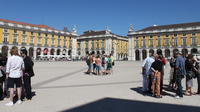Lisbon Essential Tour: History Stories Lifestyle
Lisbon, Portugal
Rating: 









Trip Type: Cultural Tours
Duration: 3 hours
Learn about important areas in Lisbon’s history as you explore its most interesting neighborhoods. Discover Chiado and Bairro Alto and admire the views from Miradouro São Pedro de Alcântara. Ride the Eleléctrico tram and visit the Alfama district.
More About This Activity All Cultural Tours →
Learn about important areas in Lisbon’s history as you explore its most interesting neighborhoods. Discover Chiado and Bairro Alto and admire the views from Miradouro São Pedro de Alcântara. Ride the Eleléctrico tram and visit the Alfama district.
Discover one of Europe's most captivating and picturesque capitals, built on a series of hills and offering panoramic views from countless spots. You’ll explore the city for 3 hours with a knowledgeable local guide who will make sure that you have an interesting and fun experience.
Your tour begins in the 5-centuries-old Bairro Alto, where you’ll learn about the evolution of the city. After the earthquake of 1755 this space attracted families from the Baixa and Bairro districts, who began the process of renewal.
Pass through the garden of São Pedro de Alcântara and enjoy stunning views of the Baixa and the south bank of the Tagus River.
Visit the church and museum of San Roque, built by the Jesuits. San Roque was one of the first Jesuit churches in Portugal and in fact, one of the first worldwide. The church has an austere façade, but an interior that features gilding, tiles, and paintings that make it a wonderful museum of Mannerist and Baroque style.
Heading down the hill, you’ll come to the Carmo convent and church, fine examples of the city’s Gothic architecture. This is a site of historical importance as it was here that the Carnation Revolution began in 1974, putting an end to nearly 5 decades of dictatorship.
A little further on, you’ll arrive at the Santa Justa elevator, an imposing monument built in the Gothic Revival style, that provides one of the best viewpoints in the city.
You’ll see a number of attractions in Baixa, in the heart of the city. After a short break, you’ll take a ride on the tram, going up from the castle to the Portas do Sol.
At the Portas do Sol you’ll see the Monastery of São Vicente de Fora, the National Pantheon, and the Alfama district that spans several narrow streets to the River Tagus.
Alfama is one of the oldest and most traditional neighborhoods of Lisbon, known for its fado houses, and the popular festivals of saints, particularly St. Anthony.
The tour ends at Lisbon Cathedral, built in 1150, 3 years after the city was taken back from the Moors. Over time it has been subject to various architectural changes, becoming a mixture of different styles.
Your tour begins in the 5-centuries-old Bairro Alto, where you’ll learn about the evolution of the city. After the earthquake of 1755 this space attracted families from the Baixa and Bairro districts, who began the process of renewal.
Pass through the garden of São Pedro de Alcântara and enjoy stunning views of the Baixa and the south bank of the Tagus River.
Visit the church and museum of San Roque, built by the Jesuits. San Roque was one of the first Jesuit churches in Portugal and in fact, one of the first worldwide. The church has an austere façade, but an interior that features gilding, tiles, and paintings that make it a wonderful museum of Mannerist and Baroque style.
Heading down the hill, you’ll come to the Carmo convent and church, fine examples of the city’s Gothic architecture. This is a site of historical importance as it was here that the Carnation Revolution began in 1974, putting an end to nearly 5 decades of dictatorship.
A little further on, you’ll arrive at the Santa Justa elevator, an imposing monument built in the Gothic Revival style, that provides one of the best viewpoints in the city.
You’ll see a number of attractions in Baixa, in the heart of the city. After a short break, you’ll take a ride on the tram, going up from the castle to the Portas do Sol.
At the Portas do Sol you’ll see the Monastery of São Vicente de Fora, the National Pantheon, and the Alfama district that spans several narrow streets to the River Tagus.
Alfama is one of the oldest and most traditional neighborhoods of Lisbon, known for its fado houses, and the popular festivals of saints, particularly St. Anthony.
The tour ends at Lisbon Cathedral, built in 1150, 3 years after the city was taken back from the Moors. Over time it has been subject to various architectural changes, becoming a mixture of different styles.
« Go Back

